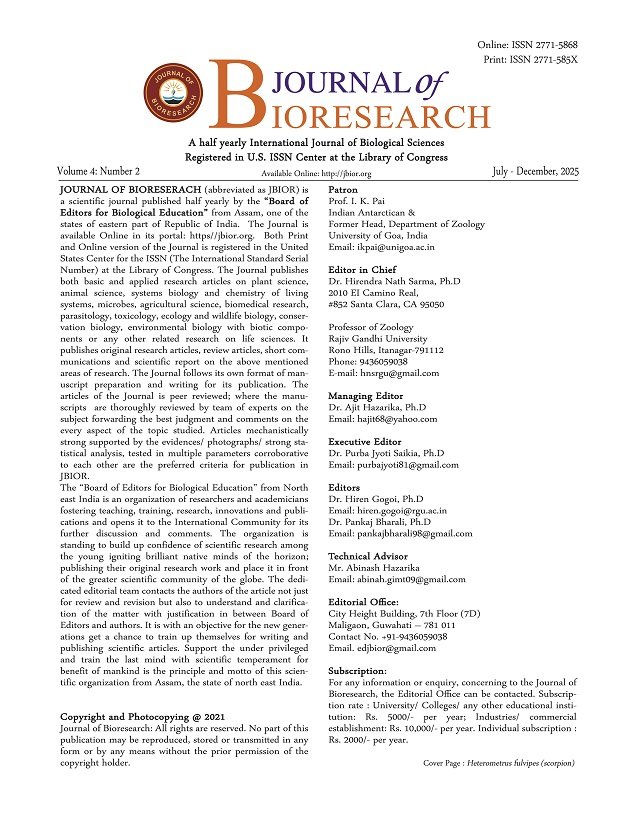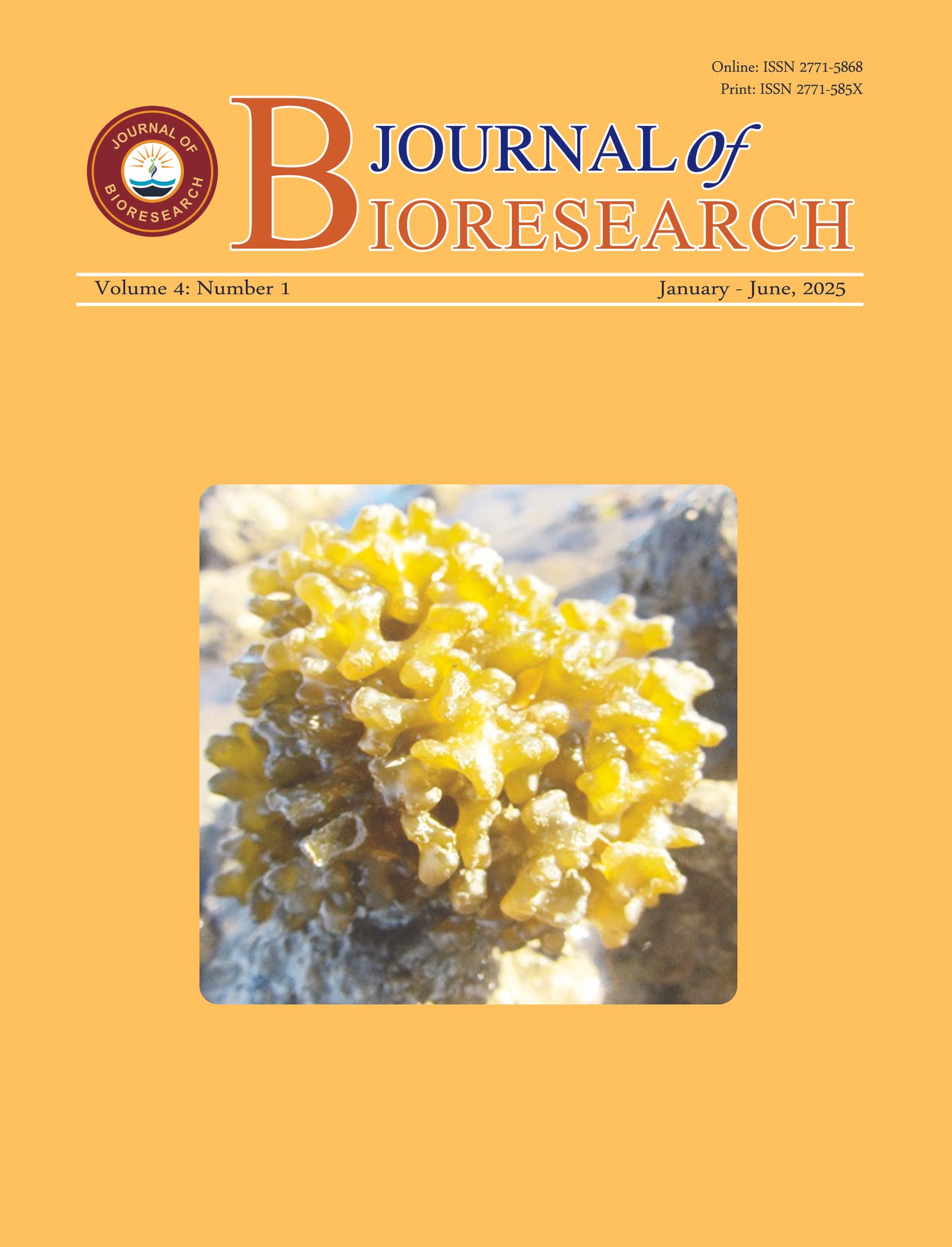Abstract: The growing demand for sustainable energy sources in the aviation industry has spurred interest in alternative
biofuels. The algal exopolysaccharides (EPS) have emerged as a promising candidate for jet fuel production. This paper
explores the potential of algal EPS as a sustainable and eco-friendly alternative to conventional jet fuels. Algal EPS offer several
advantages, including their renewability, low environmental impact, and compatibility with existing jet engine technologies.
Additionally, their carbon-neutral cycle, efficient water usage and ability to be cultivated on non-arable land make them an
ideal source for biofuel production. The chemical properties of algal EPS can be tailored to meet the specific requirements of
jet fuels, ensuring high performance, low emissions and efficient combustion. This paper discusses the potential environmental
and economic benefits of EPS-derived biofuels, including their role in reducing greenhouse gas emissions, improving energy
security and creating new industries. The integration of algae cultivation with wastewater treatment systems further enhances
the feasibility of algal EPS as a biofuel feedstock. The paper concludes by emphasizing the significance of further research and
technological advancements in making EPS-based jet fuels a viable solution for sustainable aviation fuel production.
Key words: Aviation, Biofuel, Exopolysaccharides, Nutrient Cycling
"A half yearly International Journal of Biological Sciences Registered in U.S. ISSN Center at the Library of Congress"


Review Article
Exploring the Potential of Algal Exopolysaccharides as Sustainable Jet Fuel: Environmental,Economic, and Technological Benefits
Aqsa Majgaonkar, Sandra Cyriac and Vijaya Lobo*
PDFhttps://doi.org/10.5281/zenodo.15086867
Original Research Article
Ethnobotanical Exploration of Plants Utilized by the Bhotiya Tribe in the Upper Johar Valley, Indo-Tibet Border
Mukta Martolia, Balwant Kumar*
PDFAbstract: The Johar Valley is divided into three zones – Malla Johar, Talla Johar, and Goriphat – ranging from 2200m to 3500m altitude in Munsiyari Tehsil, Pithoragarh district, Kumaon Himalaya.
The Bhotiya, the predominant tribe in the area, relies heavily on the region’s vegetation and practices transhumance. Focusing on documenting plants used by the tribe for ethnobotanical purposes, this study was conducted in the Upper Johar Valley across all 13 villages in the study area.
During the field survey, elderly individuals aged 40 to 75 were interviewed within the villages using a semi-structured questionnaire. The questionnaire was designed to collect both quantitative and qualitative data.
A total of 55 individuals were interviewed across the villages, resulting in the identification of 45 medicinal plant species belonging to 25 different families. Among these, 33 species were herbs and 6 were shrubs, with the Apiaceae, Asteraceae, and Polygonaceae families each represented by four species.
Use Value (UV) analysis for each species was also done, ranging from 0.02 to 1.0, with Allium stracheyi showing the highest UV (1.0), and Arisaema propinquum and Humulus lupulus the lowest at 0.02 each.
Additionally, the study documented nine traditional practices employed by the tribe to treat various ailments, emphasizing the depth of ethnobotanical knowledge preserved by this community.
The study concluded that there is a decline of indigenous knowledge surrounding medicinal plants among local communities in the Upper Johar Valley. Preserving this information requires urgent action, including the documentation of these plants, the implementation of educational programs, and the promotion of intergenerational knowledge-sharing initiatives.
Key words: Bhotiya tribe, Ethnomedicinal plants, Goriphat, Malla Johar, Talla Johar
https://doi.org/10.5281/zenodo.14983212
Original Research Article
Development of Biodegradable Mycelium-Based Toys Using Sugarcane Bagasse: A Sustainable Alternative to Plastic in the Toy Industry
Aaeshlesha Milind Patil
PDFAbstract: The excessive reliance on plastic in the $104.2 billion global toy industry has led to severe environmental concerns, with 90% of toys being plastic-based and 80% ultimately discarded in landfills, where they persist for up to 500 years.
Addressing this issue, this study investigates the potential of sugarcane bagasse (SCB), an abundant agricultural by-product in India, and mycelium as biodegradable alternatives for toy manufacturing. With India producing over 500 million metric tons of sugarcane annually—resulting in nearly 100 million metric tons of SCB—repurposing this waste could contribute to sustainable material development.
To evaluate SCB’s viability, four substrate forms—fine, coarse, ashed, and filter mud—were prepared and inoculated with mycelium spores. Incubation occurred under controlled conditions (25–27°C, 25–30 days), followed by prototype formation in pin and ball molds and drying at 40°C for stability.
The study assessed mycelium colonization, structural integrity, shrinkage control, dye absorption, and aroma infusion. Findings revealed that coarse SCB exhibited the highest colonization efficiency, with fine SCB supporting moderate growth, while ashed SCB and filter mud showed limited compatibility.
Developed prototypes demonstrated 88% structural integrity, 93% shrinkage control, and 80% durability. Natural dyeing with turmeric and onion peels was effective, whereas aroma infusion yielded inconclusive results.
By offering a viable, biodegradable alternative to plastic toys, this research promotes circular economy principles and waste valorization. Further exploration of material properties, large-scale production, and commercialization is essential for industry adoption.
Key words: Bio-composite material, Mycelium, Sugarcane Bagasse (SCB).
https://doi.org/10.5281/zenodo.14983244
Original Research Article
The habitat preference and population diversity of scorpions in Kesnand-Wadebolhai, Pune, Maharashtra, India
Sharad Giramkar*
PDF
Abstract: Scorpions play a vital role in maintaining ecological balance, serving as both predators and prey and also play a significant role in biodiversity. This study explores the diversity, habitat preferences, and seasonal distribution of scorpions in the Kesanand-Wadebolhai region, located in eastern Pune, Maharashtra, India. A systematic survey was conducted between June 2023 and May 2024, focusing on five prominent scorpion species belonging to the families Buthidae (Hottentotta tamulus, Orthochirus bicolor) and family Scorpionidae (Heterometrus xanthopus, Heterometrus fulvipes and Deccanometrus phipsoni).
The research employed active searching and pitfall trapping techniques to gather data on species richness, seasonal variations, population densities, and habitat associations. Statistical analysis was performed using the Shannon-Wiener and Simpson’s diversity indices, with seasonal differences assessed through one-way ANOVA and correspondence analysis to identify habitat preferences.
The results showed distinct seasonal patterns in species distribution, with the highest species richness recorded during the monsoon and post-monsoon seasons. Hottentotta tamulus and Orthochirus bicolor exhibited peak activity during the monsoon months, while Heterometrus fulvipes and Deccanometrus phipsoni were most active in the post-monsoon period.
This study highlights the ecological roles of scorpions in semi-arid ecosystems and underscores the importance of their conservation amidst increasing habitat disruption caused by human activities. The findings provide crucial insights for future scorpion conservation efforts and contribute to a better understanding of their ecological dynamics.
Key words: Habitat preferences; Kesanand-Wagholi; Scorpion diversity; Seasonal variability
https://doi.org/10.5281/zenodo.15086881
Original Research Article
Biopesticide for controlling Citrus limon (L.) Burm f. (Assam lemon) pests and diseases
Miniswrang Borgoyary1, Hayen Machahary1, Nutai Gwra Narzary2, Pforeni Jane Sapruna1 and Mohesh Gogoi3*
PDF
Abstract:
A biopesticide has been developed from Azadirachta indica A. Juss, Polygonum glabrum Willd., Cyclosorus parasiticus (L.) Farw., Curcuma longa L., Capsicum annum L. and cow urine to control insects and pests infestation on Citrus limon (L.) Burm f. (Assam lemon) grown at Kokrajhar district, BTR, Assam. Those five number of locally available medicinal plants selected for pesticide preparation were ground collectively into a fine paste using a mixer grinder along with distilled water. The paste was then sieved with a muslin cloth and squeezed to extract the solvent and diluted up to 200 ml. The resulting filtrate constitutes 50% stock solution later diluted into 1%, 5% and 10% and each solution has been mixed with 200 ml of cow urine before spray.
The strength of aqueous extracts were evaluated by foliar spray on plants and their efficacy were determined for controlling the pests and diseases. Meanwhile four pest infested lemon trees were selected and tagged S1, S2, S3 and S4. Plant tagged as S1, S2 and S3 were considered for applying biopesticide @ 1%, 5% and 10% while S4 treated as a control plant.
The said biopesticide of three different concentrations were sprayed once in a week from January 2024 to March 2025 with a hand sprayer (2L capacity). The biopesticide @10% (S3) concentration showed the best result with reduction of Diaphorina citri (Citrus psylla), Dialeurodes citri (white fly), Anoplophora versteegi (trunk borer), Phyllocnistis citrella (leaf miner) and other insect population as compared to the lemon plants - S1, S2 and S4.
Key words: Biopesticide, Citrus limon (L.) Burm f., Disease, Insect, Pest and IPM.
https://doi.org/10.5281/zenodo.15393038

